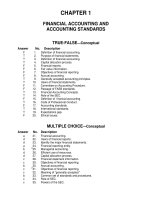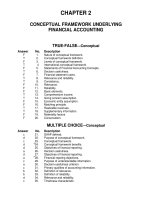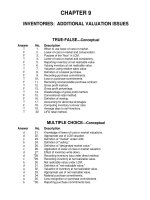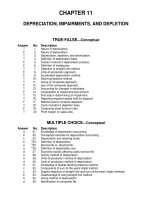Intermediate accounting 16e by kieso slide ch02
Bạn đang xem bản rút gọn của tài liệu. Xem và tải ngay bản đầy đủ của tài liệu tại đây (1.03 MB, 66 trang )
2-1
PREVIEW OF CHAPTER 2
2-2
Intermediate Accounting
16th Edition
Kieso ● Weygandt ● Warfield
2
Conceptual Framework for
Financial Reporting
LEARNING OBJECTIVES
After studying this chapter, you should be able to:
1 Describe the usefulness of a
conceptual framework.
5 Describe the basic assumptions
of accounting.
2 Understand the objective of
financial reporting.
6 Explain the application of the
basic principles of accounting.
3 Identify the qualitative
characteristics of accounting
information.
7 Describe the impact that the cost
constraint has on reporting
accounting information.
4 Define the basic elements of
financial statements.
2-3
LO 1
CONCEPTUAL FRAMEWORK
The Need for a Conceptual Framework
2-4
To develop a coherent set of standards and rules.
To solve new and emerging practical problems.
LO 1
CONCEPTUAL FRAMEWORK
Question
(true or false):
A conceptual framework underlying financial accounting is
important because it can lead to consistent standards and it
prescribes the nature, function, and limits of financial
accounting and financial statements.
True
2-5
LO 1
CONCEPTUAL FRAMEWORK
Question
(true or false):
A conceptual framework underlying financial accounting is
necessary because future accounting practice problems can
be solved by reference to the conceptual framework and a
formal standard-setting body will not be necessary.
False
2-6
LO 1
WHAT DO THE NUMBERS MEAN?
WHAT’S
YOUR
PRINCIPLE?
WHAT’S
YOUR
PRINCIPLE
The need for a conceptual framework is highlighted by accounting
scandals such as those at Enron and Lehman Brothers. To restore public
confidence in the financial reporting process, many have argued that
regulators should move toward principles-based rules. They believe that
companies exploited the detailed provisions in rules-based
pronouncements to manage accounting reports, rather than report the
economic substance of transactions. For example, many of the off–
balance-sheet arrangements of Enron avoided transparent reporting by
barely achieving 3 percent outside equity ownership, a requirement in an
obscure accounting rule interpretation. Enron’s financial engineers were
able to structure transactions to achieve a desired accounting treatment,
even if that accounting treatment did not reflect the transaction’s true
nature. Under principles-based rules, hopefully top management’s financial
reporting focus will shift from demonstrating compliance with rules to
demonstrating that a company has attained the objective of financial
reporting.
2-7
LO 1
Development
Development of
of Conceptual
Conceptual Framework
Framework
The FASB has issued seven Statements of Financial
Accounting Concepts (SFAC) for business enterprises.
2-8
SFAC No.1 -
Objectives of Financial Reporting (superseded by SFAC No. 8)
SFAC No.2 -
Qualitative Characteristics of Accounting Information.
(superseded by SFAC No. 8)
SFAC No.3 -
Elements of Financial Statements. (superseded by SFAC No. 6)
SFAC No.5 -
Recognition and Measurement in Financial Statements.
SFAC No.6 -
Elements of Financial Statements (replaces SFAC No. 3).
SFAC No.7 -
Using Cash Flow Information and Present Value in Accounting
Measurements.
SFAC No.8 -
The Objective of General Purpose Financial Reporting and
Qualitative Characteristics of Useful Financial Information
(replaces SFAC No. 1 and No. 2)
LO 1
CONCEPTUAL FRAMEWORK
Overview of the Conceptual
Framework
2-9
First Level = Basic Objectives
Second Level = Qualitative
Characteristics and Elements
Third Level = Recognition,
Measurement, and Disclosure
Concepts.
LO 1
ILLUSTRATION 2-7
Conceptual Framework for
Financial Reporting
2-10
LO 1
CONCEPTUAL FRAMEWORK
Question
What are the Statements of Financial Accounting Concepts intended to
establish?
2-11
a.
Generally accepted accounting principles in financial reporting
by business enterprises.
b.
The meaning of “Present fairly in accordance with generally
accepted accounting principles.”
c.
The objectives and concepts for use in developing standards of
financial accounting and reporting.
d.
The hierarchy of sources of generally accepted accounting
principles.
LO 1
2
Conceptual Framework for
Financial Reporting
LEARNING OBJECTIVES
After studying this chapter, you should be able to:
1 Describe the usefulness of a
conceptual framework.
5 Describe the basic assumptions
of accounting.
2 Understand the objective of
financial reporting.
6 Explain the application of the
basic principles of accounting.
3 Identify the qualitative
characteristics of accounting
information.
7 Describe the impact that the cost
constraint has on reporting
accounting information.
4 Define the basic elements of
financial statements.
2-12
LO 2
FIRST
FIRST LEVEL:
LEVEL: BASIC
BASIC OBJECTIVES
OBJECTIVES
Objective of financial reporting:
To provide financial information about the reporting entity that
is useful to present and potential equity investors,
lenders, and other creditors in making decisions about
providing resources to the entity.
2-13
LO 2
FIRST Level: Basic Objectives
Question
According to the FASB conceptual framework, the objectives
of financial reporting for business enterprises are based on?
a. Generally accepted accounting principles
b. Reporting on management’s stewardship.
c. The need for conservatism.
d. The needs of the users of the information.
2-14
LO 2
2
Conceptual Framework for
Financial Reporting
LEARNING OBJECTIVES
After studying this chapter, you should be able to:
1 Describe the usefulness of a
conceptual framework.
5 Describe the basic assumptions
of accounting.
2 Understand the objective of
financial reporting.
6 Explain the application of the
basic principles of accounting.
3 Identify the qualitative
characteristics of accounting
information.
7 Describe the impact that the cost
constraint has on reporting
accounting information.
4 Define the basic elements of
financial statements.
2-15
LO 3
SECOND
SECOND LEVEL:
LEVEL: FUNDAMENTAL
FUNDAMENTAL
CONCEPTS
CONCEPTS
Qualitative Characteristics of Accounting
Information
“The FASB identified the qualitative characteristics of
accounting information that distinguish better (more useful)
information from inferior (less useful) information for
decision-making purposes.”
2-16
LO 3
Second Level: Fundamental Concepts
ILLUSTRATION 2-2
Hierarchy of Accounting
Qualities
2-17
LO 3
Relevance
Relevance
ILLUSTRATION 2-7
Conceptual Framework for
Financial Reporting
2-18
LO 3
Second Level: Fundamental Concepts
Fundamental Quality—Relevance
To be relevant, accounting information must be capable of making
a difference in a decision.
2-19
LO 3
Second Level: Fundamental Concepts
Fundamental Quality—Relevance
Financial information has predictive value if it has value as an input
to predictive processes used by investors to form their own
expectations about the future.
2-20
LO 3
Second Level: Fundamental Concepts
Fundamental Quality—Relevance
Relevant information also helps users confirm or correct prior
expectations.
2-21
LO 3
Second Level: Fundamental Concepts
Fundamental Quality—Relevance
Information is material if omitting it or misstating it could influence
decisions that users make on the basis of the reported financial
information.
2-22
LO 3
WHAT DO THE NUMBERS MEAN?
LIVING
INYOUR
A MATERIAL
WORLD
WHAT’S
PRINCIPLE
The need for a conceptual framework is highlighted by accounting
scandals such as those at Enron and Lehman Brothers. To restore public
confidence in the financial reporting process, many have argued that
regulators should move toward principles-based rules. They believe that
companies exploited the detailed provisions in rules-based
pronouncements to manage accounting reports, rather than report the
economic substance of transactions. For example, many of the off–
balance-sheet arrangements of Enron avoided transparent reporting by
barely achieving 3 percent outside equity ownership, a requirement in an
obscure accounting rule interpretation. Enron’s financial engineers were
able to structure transactions to achieve a desired accounting treatment,
even if that accounting treatment did not reflect the transaction’s true
nature. Under principles-based rules, hopefully top management’s financial
reporting focus will shift from demonstrating compliance with rules to
demonstrating that a company has attained the objective of financial
reporting.
2-23
LO 3
Faithful
Faithful Representation
Representation
ILLUSTRATION 2-7
Conceptual Framework for
Financial Reporting
2-24
LO 3
Second Level: Fundamental Concepts
Fundamental Quality—Faithful Representation
Faithful representation means that the numbers and descriptions
match what really existed or happened.
2-25
LO 3









